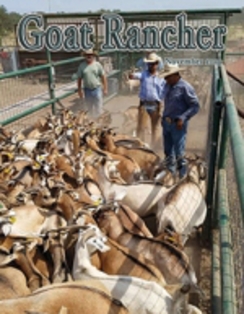What's that smell?
Friday, November 1, 2019
Goats are unique: from their color and body structure to their personalities. They can make you laugh. Sometimes you end up in the wrong place and get a bump or a hard knock, so at times, they definitely can make you cry. They are a ton of work and more importantly, they are a ton of fun and bring a sense of accomplishment at the end of the day.
Now let’s go back a year, five years, ten years, or even thirty years. You’re a new goat owner. You’re puttering around at the barn. Let’s face it, that’s what we goat producers do best. All of sudden you see your big, broad, burly buck curling his upper lip and stretching his neck up…almost like he is sniffing the air? And you chuckle, maybe snort, or even laugh out loud; and think, what in tarnation is that big guy doing this time?
I’m sure we are all very familiar with our goats curling their upper lip. We often see this occur during the breeding season, especially when our bucks are getting a good whiff of the does. What you may not know is that this action has a name: at times, some very informal and funny names we come up with on our farms. Okay! You probably figured the action had a name, but you may not know the actual name of the action. This action is called the Flehmen Response. This response is exhibited in many different animals including horses, giraffes, big and small cats, donkeys, cows, and even rhinos.
Fun fact, flehmen means “to bare the upper teeth” in German. This to me is rather ironic as when our goats do this, we only see the fleshy, upper palate…no teeth! This response is generally associated with bucks during the mating season. Interestingly enough, this response is exhibited by both males and females, at any time of the year. We see this response in both males and females, during any time of the year, because this display is simply to gather more information about something the animal smells.
In doing a little research, I discovered what I generally find when doing some goat research. It can be very difficult to find statistics and information on goats. Sheep are the far more common studied small ruminant. While they are very similar, there are some key differences physically, behaviorally, as well as, physiologically, but that’s a talk for another day. As for the Flehmen Response, there are virtually no differences.
Now, for a little physiology lesson. I’m no scientist, but here’s what I dug up. The Flehmen Response draws air into the Jacobson’s Organ, or the vomeronasal organ (VNO), an olfactory sense organ common among many animals. The organ is named for the vomer and nasal bones, which are found in humans as well…wouldn’t it be funny if humans ran around doing this too? Animals that exhibit this response have a duct behind their incisors that connects the oral cavity to the VNO. A chemical cue is then obtained when the animals take this position.
The main function of this response is to transfer air containing pheromones and other scents to the organ. This information is then used in several ways. Largely in goats, the response is used to identify reproductive status. A male will generally use the Flehmen Response as an olfactory mechanism to understand whether the female is in heat by smelling her urine. In other species, the response has been correlated with reproductive synchrony, as well as, a sign of maturity in elephants.
What we have recently found on our small farm in rural Maine is that this response is simply a self-communication method. Goats use this response when they smell something they are interested in and use it to gather information about this fascinating smell. Now, generally, we see this in our males, but sometimes in our females, as well, for several reasons. Urine, feces, and birthing fluids are often investigated using this response. You just don’t get a chance to see does curling their lips and putting their nose in the air, in response, like we do bucks. So it is comical to watch.
Well, we have a new development here at Marble Creek Acres, but first, a little background. Back in May of this year, my mom, Kathy, and I traveled to West Virginia for the Mountain Premier Invitational Sale. Now, these auctions are usually my father, Josh’s, responsibility, with supervisory support from my mom, my brother, and I. He does the research. He works the sale catalog. Due to a last-minute change in our goat caretaker (Gpa), my dad had to stay home and care for the kids. As a result, my mom and I set out on our first solo goat endeavor.
This was our first time at the Mountain Premier Invitational, their second invitational, and it was a big hit. We hope to go again next year. The sale was also a great success for us. We brought home two beautiful does, a blue girl I added to my own sub-herd named Azul, and a tan girl named Opal that my dad added to his herd. While the sale was very successful, the ride home was rather interesting. Opal rode the entire way home buried under the hay in order to stay away from Azul (which sounds just like the way she was acting). Needless to say, we eventually made it home and our two new girls have integrated well into the collective herd in the last five months.
Now back to our newest development, a change we observed in Opal. Opal began, and remains, a standoffish goat when it comes to people. Now, we are operating a business, but having friendly goats only adds to our success in the long run; we have worked very hard to make progress with some of our more anti-human goats, Opal being no exception. Over the last few months, we have enticed her with treats in order to make friends. Slowly we have made progress. She still runs from our touch, but as she thinks we carry treats all the time, she now constantly sniffs and nuzzles our hands to figure out what might be concealed in our hands.
And that’s just it. In trying to figure out what we have, Opal has taken to demonstrating the Flehmen Response every single time she sniffs a human. Whether we are ungloved, wearing work gloves, carrying snacks, it doesn’t matter. She immediately stretches her neck out and curls that upper lip. This phenomenon threw us for a loop. This was the first time one of our goats had produced the Flehmen Response when sniffing a human, and at that, doing it every single time she smells us. To this day, she is the only doe we have ever seen doing this. An interesting thing we have uncovered...if you buy mint cookies covered in chocolate from Walmart, then proceed to rub your fingers on the minty smelling coating, and then allow Opal to sniff your fingers, within seconds she draws back and curls her lip. When she’s decided she can’t figure out the smell, she comes back in for another trace smell to try and figure it out again.
Every day on the farm is quite an adventure. As I said before, we are working towards operating a successful business. That being said, it doesn’t feel like ‘work’. Yes, there is constantly physical work to be done on the farm, but there is always a bit of fun involved at all times. As we operate a small farm, we interact with each goat daily. By doing so we can observe each animal and get to know all their personalities: every single quirk and thing about them that makes them unique, including a doe who throws her head back and curls her lip when interacting with humans…trying to figure out, “human what’s that smell?”
(Josh and Kathy Crise, and their grown children, Amelia and Kevin, operate Marble Creek Acres in Lee, Maine. For interest in a future year’s Kiko waitlist, questions or if you have topics you might like to read about in a future Goat Rancher, we can be reached at 207-619-3758, email [email protected] or marblecreekacres.com)



